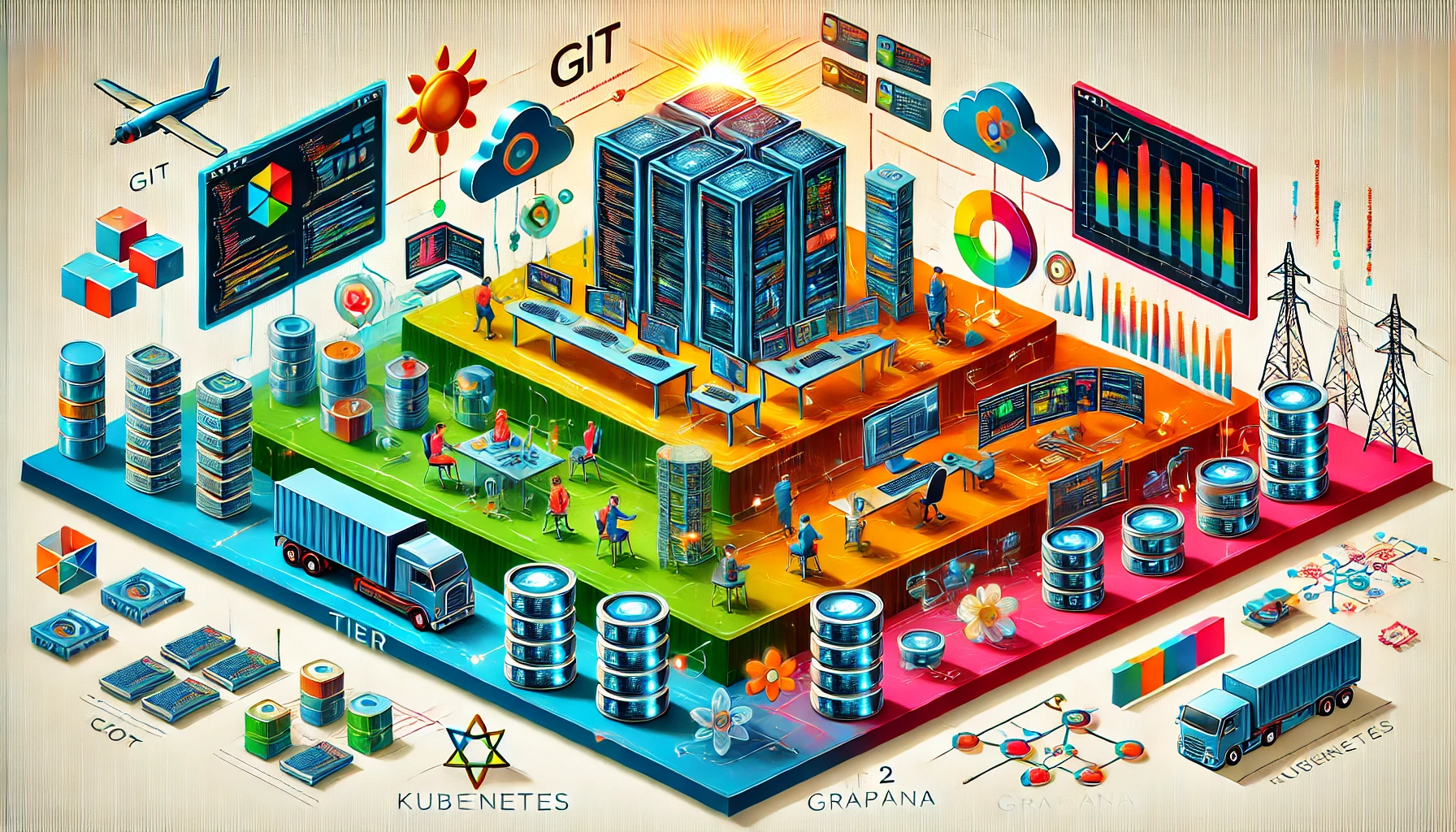Unlocking Scalability: Mastering the 3-Tier DevOps Pipeline Architecture
The Foundation – Source Code Management and Continuous Integration
Introduction: Unveiling the Secrets of Scalable DevOps Pipelines :-
The Allure of Efficiency: Why DevOps Pipeline Optimization Matters
- In today's fast-paced digital world, the speed and efficiency of software delivery are paramount. A well-optimized DevOps pipeline is no longer a luxury, but a necessity for businesses to stay competitive. Slow, inefficient pipelines lead to delayed releases, increased costs, and frustrated developers. By streamlining your DevOps pipeline, you can significantly reduce deployment times, improve code quality, and boost team morale. Imagine releasing bug-free features weekly instead of monthly – that's the power of optimization.
- The benefits extend beyond speed. An efficient pipeline allows for more frequent releases, enabling faster feedback loops and quicker responses to market changes. This agility is critical in an environment where customer demands are constantly evolving. It empowers teams to experiment more, fostering innovation and ultimately leading to better products. Think of Netflix, constantly releasing new features and A/B testing variations. This is a direct result of a highly efficient DevOps pipeline.
Introducing the 3-Tier Architecture: A Scalable Solution :-
- This blog post explores a 3-tier architecture designed for scalability and efficiency. Each tier plays a crucial role in the seamless flow of code from development to production. This structured approach ensures modularity and allows for independent scaling of individual components. This is unlike monolithic approaches where a single bottleneck can cripple the entire system. The 3-tier architecture enables the smooth handling of increased load and complexity.
- This approach is not merely theoretical. It is a practical solution adopted by many successful organizations. By breaking down the pipeline into manageable tiers, we can focus our efforts on optimizing each stage individually. This approach reduces complexity, making it easier to identify and resolve bottlenecks. This architecture promotes a more robust and resilient system, capable of adapting to changing demands.
Tier 1: The Foundation - Source Code Management and Continuous Integration :-
Version Control Systems: Git and Beyond
- The foundation of any successful DevOps pipeline lies in robust source code management. Git, the most popular distributed version control system (DVCS), is the cornerstone. Git allows multiple developers to collaborate seamlessly on the same codebase, tracking changes, managing revisions, and facilitating efficient merges. The ability to easily revert to previous versions is invaluable for debugging and managing unexpected issues. Imagine a scenario where a crucial bug is introduced – Git allows developers to quickly undo these changes, minimizing downtime.
- Beyond Git, other version control systems exist, each with its strengths and weaknesses. The choice depends heavily on project needs and team preferences. But regardless of the system used, having a centralized and well-managed repository is crucial for maintaining code integrity and efficient collaboration. Centralized version control simplifies project management and provides an easily accessible history of code changes. This is crucial for audits and compliance.
Continuous Integration (CI) Servers: Automating the Build Process :-
- Continuous Integration (CI) automates the build process, ensuring that code changes are integrated frequently and tested rigorously. CI servers, like Jenkins, GitLab CI, or CircleCI, automatically build the codebase whenever changes are pushed to the repository. This prevents integration conflicts and identifies issues early in the development cycle. This is far more efficient than manual integration, which is prone to errors and delays.
- These servers facilitate automated testing, ensuring code quality. They perform unit tests, integration tests, and other automated checks to prevent bugs from making it into production. This proactive approach dramatically improves software quality. Imagine how much time and resources are saved by catching bugs early in the process instead of in production!
Code Quality Checks: Static Analysis and Unit Testing :-
- Static analysis tools automatically check code for potential errors and vulnerabilities without executing it. This process identifies coding style violations, potential bugs, and security risks. These tools are incredibly valuable for maintaining code quality and preventing security issues. Imagine an SQL injection vulnerability being caught before release – this is a huge win.
- Unit testing is another critical component. Unit tests are small, isolated tests that verify the functionality of individual units of code. Writing comprehensive unit tests ensures that each component works as expected, contributing to a more robust and reliable system. Well-written unit tests significantly reduce debugging time and simplify future modifications. The goal is to create a safety net that catches errors before they propagate throughout the application.
Tier 2: The Core - Automated Testing and Deployment
Automated Testing Strategies: Ensuring Quality :-
- Automated testing is the backbone of a reliable DevOps pipeline. It's not just about unit tests; it encompasses various strategies, including integration tests, system tests, and end-to-end tests. Integration tests verify the interaction between different components of the system, while system tests test the entire system as a whole. End-to-end tests simulate real-world user scenarios, ensuring that the system works as expected from a user's perspective.
- The choice of testing strategies depends on the complexity of the application and the specific needs of the project. However, the common thread is automation. Automating these tests reduces the time and effort required for testing, increases test coverage, and significantly improves software quality. Consider the immense cost savings from preventing issues during integration as opposed to fixing them in production.
Deployment Automation: Infrastructure as Code (IaC) :-
- Infrastructure as Code (IaC) automates the provisioning and management of infrastructure. Tools like Terraform or Ansible define infrastructure as code, allowing for consistent and repeatable deployments. This eliminates manual configuration, reduces errors, and speeds up deployment times. Imagine deploying a new server in minutes instead of hours - this is the power of IaC.
- IaC is a fundamental aspect of scalability. It ensures that the infrastructure can be easily scaled up or down to meet changing demands. This is essential for handling peak loads and ensuring high availability. It allows for consistent and predictable deployment across different environments, from development to production.
Containerization with Docker and Kubernetes: Managing Microservices :-
- Containerization technologies like Docker and Kubernetes are transforming the way applications are deployed and managed. Docker creates lightweight, portable containers that package applications and their dependencies. Kubernetes orchestrates these containers, managing their deployment, scaling, and networking. This approach simplifies microservices architecture, allowing for independent scaling and deployment of individual components.
- This is crucial for scalability and resilience. If one microservice fails, it doesn't bring down the entire application. The ability to independently scale individual components allows for efficient resource utilization and improved performance. Imagine the agility of updating a single microservice without affecting the rest of the application; this is a significant advantage.
Tier 3: The Apex - Monitoring, Feedback, and Continuous Improvement :-
Monitoring Tools: Real-time Insights into Performance
- Monitoring tools provide real-time insights into the performance and health of the application and infrastructure. Tools like Prometheus, Grafana, or Datadog collect metrics, logs, and traces, providing comprehensive visibility into the system's behavior. This data is crucial for identifying bottlenecks, resolving issues, and ensuring high availability.
- Real-time monitoring enables proactive problem-solving. Instead of reacting to outages, teams can identify potential issues before they impact users. This allows for timely intervention and prevents major disruptions. The ability to track key performance indicators (KPIs) and receive alerts empowers teams to address issues efficiently, ensuring smooth operation.
Feedback Loops: Gathering Data for Optimization
- Continuous feedback is critical for continuous improvement. Collecting user feedback, analyzing logs, and monitoring performance metrics provides valuable data for optimizing the pipeline. This iterative process enables teams to identify areas for improvement and adapt their processes accordingly.
- Effective feedback loops involve various channels, from user surveys and bug reports to automated monitoring alerts. Analyzing this diverse data reveals patterns and insights that guide improvements. It allows for data-driven decision-making, leading to more efficient and reliable processes. Continuous refinement is a core principle of DevOps.
Continuous Improvement: The DevOps Cycle
- The DevOps cycle is iterative, focusing on continuous improvement. Teams regularly review their processes, identify bottlenecks, and implement changes to optimize the pipeline. This iterative approach promotes a culture of learning and improvement.
- The goal is to continuously improve the speed, efficiency, and reliability of the software delivery process. This involves regular retrospectives, analyzing data, and implementing changes based on learnings. The process is never truly complete; it's a journey of continuous improvement. This adaptable mindset is crucial for staying competitive in a rapidly evolving landscape.
Conclusion: Embracing the Future of Scalable DevOps
- Adopting a scalable 3-tier architecture for your DevOps pipeline is a strategic move towards efficient and reliable software delivery. By focusing on source code management, automated testing, and continuous monitoring, organizations can achieve significant improvements in speed, quality, and scalability. This approach not only streamlines the development process but also fosters a culture of continuous improvement, preparing businesses for future growth and challenges. Embracing this architecture is a step towards a future where software deployment is seamless, efficient, and optimized for success.
Review
Kalpesh Shewale
I am grateful to have completed my Full Stack Development with AI course at Apnaguru. The faculty's support and interactive classes helped me discover my potential and shape a positive future. Their guidance led to my successful placement, and I highly recommend this institute.
Kalpesh Shewale
I am grateful to have completed the Full Stack Development with AI course at Apnaguru. The faculty's dedicated support and hands-on approach during the classes enabled me to unlock my potential and shape a promising future. Their guidance helped me secure a placement with a good package. I highly recommend this course, and for those interested, I also suggest doing the offline version at the center for an enhanced learning experience.

Raveesh Rajput
Completing the Full Stack Development with AI course at Apnaguru was a game-changer for me. I secured an internship through this course, which gave me invaluable hands-on experience. I strongly recommend this course to anyone looking to break into the tech industry. For the best experience, I suggest attending the offline sessions at the center, where the interactive learning environment really enhances the overall experience.

swapnil shinde
Apnaguru’s Full Stack Development with AI course provided me with more than just knowledge—it opened doors to an internship that gave me real-world, hands-on experience. If you're serious about a career in tech, this course is a must. I highly recommend attending the offline sessions for the most immersive and interactive learning experience!
Kalpana Waghmare
I recently completed the Full Stack Developer with AI course on ApnaGuru, and I couldn’t be more impressed! The structure of the course, with well-organized topics and self-assessment MCQs after each section, really helped reinforce my learning. The assignments were particularly valuable, allowing me to apply what I learned in a practical way. Overall, it’s an excellent program that effectively combines full-stack development and AI concepts. Highly recommended for anyone looking to enhance their skills!
Completing the Full Stack Development with AI course at Apnaguru was a pivotal moment in my career. It not only deepened my understanding of cutting-edge technologies but also directly led to an internship that provided practical, real-world experience. If you're aiming to enter the tech field, this course is an excellent stepping stone. I especially recommend attending the in-person sessions at the center, where the dynamic, hands-on learning approach truly maximizes the benefits of the program.

Mahesh Bhosle
I completed the Full Stack Development course at Apnaguru, and it was a valuable experience. The focus on live assignments and projects gave me real-world insights, helping me apply my skills in a professional setting. The interactive live sessions, mock interviews, and question banks were excellent for job preparation. Apnaguru’s company-like environment also helped me get accustomed to real work dynamics. Overall, this course equipped me with the skills and confidence needed for a career in full-stack development. I highly recommend it to anyone seeking hands-on learning and industry relevance.
I recently completed the Full Stack course at ApnaGuru, and I’m genuinely impressed! The curriculum is well-structured, covering both front-end and back-end technologies comprehensively. The instructors are knowledgeable and provide hands-on experience through practical projects. The supportive community and resources available made learning enjoyable and engaging. Overall, it’s a great choice for anyone looking to kickstart a career in web development. Highly recommend!

Adarsh Ovhal
I recently participated in the Full Stack Development With AI Course program, and it has been incredibly beneficial. The guidance I received was tailored to my individual needs, thanks to their advanced use of AI tools. The Trainers were knowledgeable and supportive, helping me explore various educational and career paths. The resources and workshops provided were practical and insightful, making my decision-making process much clearer. Overall, I highly recommend this program to any student looking for IT Field and personalized career guidance!
Shirish Panchal
I’m currently pursuing the Full Stack Developer with AI course at ApnaGuru Training Center, and I'm impressed with what I've experienced so far. The curriculum is well-structured, covering key concepts in both front-end and back-end development, along with AI fundamentals. The instructors are knowledgeable and supportive, which makes it easy to engage and ask questions. I particularly appreciate the hands-on projects that help reinforce what I’m learning. While I’m still in the process of completing the course, I feel that I'm building a strong foundation for my future in tech. I would recommend ApnaGuru to anyone looking to explore full stack development with AI!
Apnaguru Training Center stands out as a top-notch institute for IT education. They provide a wide array of courses, including Full Stack Development, Java Full Stack, Python, Automation Testing, DevOps, and MERN/MEAN Stack, all designed to meet the demands of the modern tech industry.

Mahesh Bhosle
Apnaguru Training Center is a fantastic place for IT education! They offer a variety of courses, including Full Stack Development, Java Full Stack, and Python, all taught by knowledgeable instructors who are committed to student success. The curriculum is up-to-date and includes hands-on projects that enhance learning.
dandewar srikanth
I had an excellent experience with the full-stack web development program at APNAGURU. The instructor had in-depth knowledge of both frontend and backend technologies, which made the concepts easy to grasp. From working on HTML, CSS, JavaScript, and React for the frontend to Node.js and MongoDB for the backend, the learning curve was very smooth.
